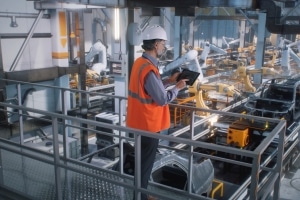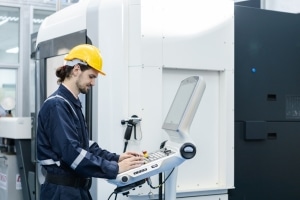Condition monitoring is an essential aspect of modern industrial operations. By continuously monitoring the health of machinery and equipment, companies can identify potential issues before they become critical, preventing costly downtime, and increasing productivity.
Traditionally, trained technicians carry out condition monitoring manually and inspect equipment for signs of wear and tear or damage. However, with the advent of sophisticated software and advanced sensors, the process can now be automated, enabling companies to monitor their assets in real-time, identify degradation patterns, and accurately predict maintenance needs.
Condition monitoring software is at the heart of this revolution. It is a powerful tool that enables engineers and operators to track the health of their equipment, predict failure, and schedule maintenance proactively.
In this article, we will explore the benefits of using condition monitoring software, the key features to look for in such software, and how it can be integrated with other systems to create a comprehensive predictive maintenance program. Orases helps develop condition monitoring software that is made to work and scale with your organization’s unique needs.
What Is Condition Monitoring Software?
 Condition monitoring software is a computer program designed to monitor the performance and health of industrial equipment and machinery in real-time. The software utilizes advanced sensors and algorithms to collect and analyze data from various sources, such as vibration, temperature, and other types of sensors, to detect any signs of wear and tear or damage.
Condition monitoring software is a computer program designed to monitor the performance and health of industrial equipment and machinery in real-time. The software utilizes advanced sensors and algorithms to collect and analyze data from various sources, such as vibration, temperature, and other types of sensors, to detect any signs of wear and tear or damage.
By analyzing the data collected by the sensors, the software can identify patterns of degradation, predict potential failures, and provide early warnings when maintenance is needed. This helps businesses to avoid costly downtime, increase productivity, and extend the life span of their assets.
The market for condition monitoring is substantial. The global machine condition monitoring market is projected to increase from USD $2.8 billion in 2022 to USD $4.0 billion by 2027, at a compound annual growth rate (CAGR) of 7.8% from 2022 to 2027, according to Markets and Markets.
Organizations can use condition monitoring software for a wide range of industrial applications, including manufacturing, energy, transportation, and others. Additionally, companies can deploy the software on-premises or in the cloud and integrate it with other systems, such as enterprise asset management (EAM) systems and computerized maintenance management systems (CMMS), to create a comprehensive predictive maintenance program.
Overall, condition monitoring software is a powerful tool for any organization that relies on heavy machinery and equipment. It helps ensure that equipment is maintained in good working condition, reducing the risk of breakdowns and extending the life of critical assets.
What Are the Key Features of Condition Monitoring Software?
Condition monitoring software typically includes a range of features that helps businesses track the health and performance of their assets. Some key features of condition monitoring software include:
- Real-time monitoring: The ability to track asset health in real-time, collecting data and providing instant alerts when issues are detected.
- Data analytics: The software can use data analytics and machine learning algorithms to identify patterns, predict maintenance needs, and provide insights for improving asset performance.
- Remote monitoring: The ability to monitor assets from remote locations helps reduce costs and improve efficiency.
- Sensor integration: The software can integrate with various sensors that collect data on key performance indicators, such as temperature, vibration, and pressure.
- Customizable dashboards: There are customizable dashboards that allow organizations to view real-time data on asset health and performance clearly and concisely.
- Maintenance scheduling: It can schedule and plan maintenance tasks based on asset health and performance data, ensuring that maintenance is performed promptly and efficiently.
- Alert notifications: The software provides automatic alert notifications when an asset issue is detected, allowing maintenance teams to respond quickly to problems and minimize downtime.
- Historical data analysis: The ability to store and analyze historical data on asset performance helps companies make informed decisions about asset management and future investments.
 Not all condition monitoring software systems are identical, and many are nuanced to the specific industry in which they are used. For instance, manufacturing condition monitoring software focuses almost exclusively on monitoring machinery and conditions related to manufacturing equipment. However, most software solutions aimed toward providing remote monitoring for businesses with specialty equipment and specialized needs will bear some similarities.
Not all condition monitoring software systems are identical, and many are nuanced to the specific industry in which they are used. For instance, manufacturing condition monitoring software focuses almost exclusively on monitoring machinery and conditions related to manufacturing equipment. However, most software solutions aimed toward providing remote monitoring for businesses with specialty equipment and specialized needs will bear some similarities.
How Is Condition Monitoring Software Integrated?
Condition monitoring software can be integrated into an organization’s existing infrastructure in several ways, depending on the specific software and hardware being used. Here are a few common integration methods:
- Sensor integration: The condition monitoring software integrates with sensors already installed on the monitored assets. These sensors collect data on key performance indicators such as temperature, vibration, and pressure, and send that data to the software for analysis.
- Programmable logic controller (PLC) integration: Some condition monitoring software can integrate with PLCs, which are used to control and automate industrial processes. By integrating with a PLC, the software can collect data on the status of machinery and can provide other equipment status updates.
- Application programming interfaces (APIs): Some condition monitoring software offers APIs that allow it to be integrated with other systems and applications, such as enterprise resource planning (ERP) software, manufacturing execution systems (MES), or other maintenance management software.
- Cloud-based integration: Many condition monitoring software solutions are cloud-based, which means they can be accessed and integrated into a business’s infrastructure via the internet. This is a convenient and cost-effective way to implement condition monitoring, as it can eliminate the need for on-premises hardware and software.
The integration of condition monitoring software depends on the specific software being used and the needs of the company. Therefore, it is important to carefully evaluate different software solutions and their integration capabilities before deciding on your company’s choice of software.
What Advantages Does Condition Monitoring Software Provide?
 Investing in a condition monitoring system brings significant benefits to an organization. By continuously monitoring the health of assets and machinery, companies can identify potential issues before they become critical, avoid costly downtime, and increase productivity.
Investing in a condition monitoring system brings significant benefits to an organization. By continuously monitoring the health of assets and machinery, companies can identify potential issues before they become critical, avoid costly downtime, and increase productivity.
One of the advantages of using a condition monitoring system includes reduced maintenance costs, extended asset life, improved safety, and increased operational efficiency. How companies use condition monitoring systems to implement predictive maintenance strategies and how they integrate them with other systems to create a comprehensive asset management program follows:
1. Monitoring Assets in Real Time
Real-time monitoring of assets allows for the assessment of their health, with maintenance being performed only when the indicators do not meet expectations. These indicators may include temperature, vibration, and key performance indicators (KPIs).
Through condition monitoring, businesses can access a constantly evolving data pool about their machinery. This data is highly valuable in analyzing key performance indicators and enhancing production processes, providing information to make informed decisions about equipment performance, supplier contracts, and equipment purchases.
2. Minimized Maintenance Expenses
Unexpected asset failure can be more costly than regular maintenance, as it often requires urgent repairs to restore the asset to operational condition. Real-time asset monitoring helps companies avoid these expenses by allowing them to check the performance and condition of their assets, with condition monitoring providing extensive data and analytics to improve asset monitoring.
This results in significant savings on maintenance expenses, allowing organizations to stay abreast of the condition of their assets at all times.
3. Extending Asset Life
Preventing unexpected equipment shutdowns can help safeguard its physical integrity by avoiding damage to its components. This results in lower costs for replacing parts and increased equipment longevity.
Maintaining the original parts of the asset and ensuring regular maintenance extends its life span, leading to lower operational costs.
4. Prioritizing Maintenance Activities
 Consistent and dependable updates on the condition of equipment and assets allow organizations to create a prioritized list of maintenance tasks.
Consistent and dependable updates on the condition of equipment and assets allow organizations to create a prioritized list of maintenance tasks.
This prioritized list helps organizations connect with maintenance firms and arrange their projects around planned tasks, resulting in considerable time and money savings. Without a clear understanding of the priority of assets, maintenance teams may operate on a first-come-first-serve basis, potentially resulting in inefficiencies and increased costs.
Inefficient asset maintenance practices result in productive work being delayed due to important assets waiting for maintenance, causing critical time wastage and production delays. Prioritizing the maintenance of assets is crucial to avoid these issues, with condition monitoring software being a key component of modern maintenance management systems.
5. Reducing Downtime
Regular maintenance for assets leads to improved performance and uptime, reducing the risk of sudden equipment failure and the resulting downtime. For companies with many assets, investing in an automated maintenance system like an asset condition monitoring system is beneficial in ensuring that maintenance is performed on time and efficiently.
Where To Find Condition Monitoring Software
Condition monitoring software is essential for any business that relies on equipment or assets to run its operations. By providing real-time monitoring, predictive maintenance, and automated alerts, condition monitoring software helps prevent unexpected downtime, reduces maintenance costs, and extends the lifespan of your equipment.
Orases, a company that provides custom software solutions, helps businesses integrate this technology into their operations to improve efficiency and profitability. Their experienced specialists are ready to assist every organization with their software needs. As a result, businesses gain a competitive edge and improve their bottom line by investing in condition monitoring software. Contact Orases today or call us at (301)756-5527 to learn more about how they can help your business benefit from this powerful tool.




